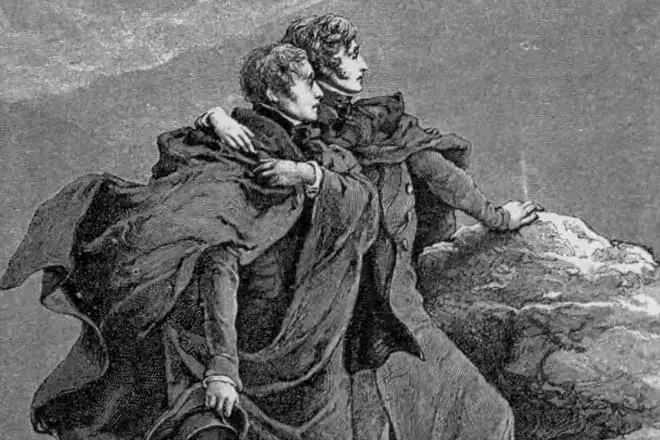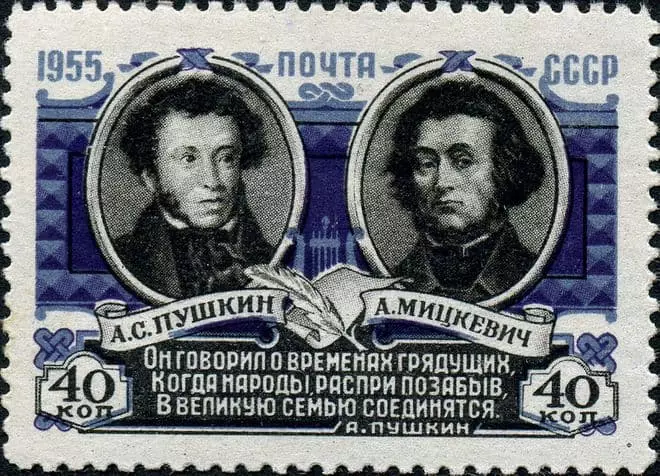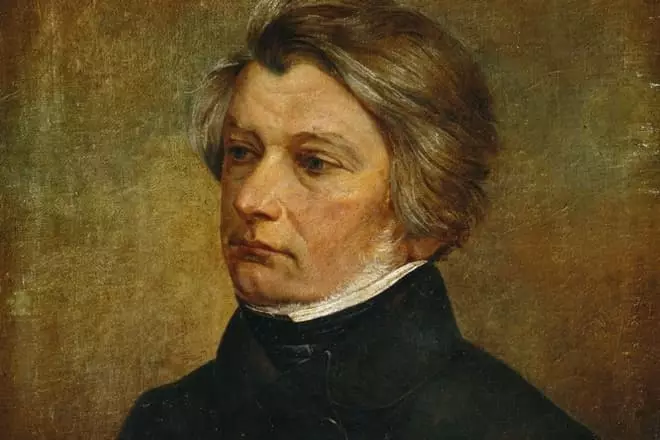Biography
Adam Mitskevich is the famous Polish poet, whose activity for the native country is comparable to the significance of Alexander Pushkin for Russian literature. Specialists call the author to the founder of Polish romanticism. He stood at the head of the national liberation movement in Poland.Childhood and youth
Adam Mitskevich was born on the Kossos farm, near the town of Novogrudok. 3 years before the author's appearance, these lands belonged to the Commonwealth, and then were attached to the Russian Empire. Today, the territory belongs to Belarus, so local residents know about the work of the poet.
Adam was born on December 24, 1798. The father of the boy, Mikolai, was a leaving from the ancient Lithuanian kind. Once he belonged to the nobility, but the family was depleted and did not have a condition. Mitskevich-Sr. led to the law practice to feed the family. In 1794, the man supported the uprising of Tadeusch Kostyutko and in his sons he brought up love for his homeland and respect for the gentry. Barbara's mother, a Jew in origin, belonged to the family of a small employee.
On February 12, 1799, the boy was baptized in Novogrudsky Church of the Transfiguration of the Lord. From 1805 to 1815, he studied at the Dominican school, founded at the temple of St. Archangel Michael, and was carried away there with literary creativity. The first poems Mitskevich wrote in adolescence. He liked to learn.
Tracting for knowledge and diligence helped to receive a stateless scholarship and go to Vilen University, whose student he became in 1815. First, the main focus of Mitskevich was physics and mathematics, but in a year the young man was transferred to the Historical and Philology Faculty. Interest in literature and history turned out to be stronger.
At the new faculty, the student began to read the antique works in the original, studied foreign languages and visited lectures of famous teachers. The teachers helped to form a world-acting attitude towards the facts and what is happening in the world. Classic ideas in their lectures were mixed with new-fashioned romantic trends that fueled the young men.
Since 1817, Mitskevich was in the ranks of students who participated in the creation of patriotic university associations: phylomates and phylaretov. Patriots of the native country, they fought for the preservation of their native language and national dignity, promoted help in need. Later, their beliefs were formed into a political program.
Having received a diploma at the end of the University in 1819, Mitskevich gained the possibility of pedagogical practice. He was sent to the city of Kovno, now Kaunas. Speaking towards such a step, officials dominated at the University of Vilensky, tried to protect the poet from participating in secret organizations. A kind of link laid the beginning of the creation of works in the spirit of romanticism. Mitskevich wrote ballads and poems, describing his views and worldview.
Poetry
In 1822, the debut book of the poems of Adam Mitskevich's poems appeared. The first volume of the writings was called "Poetry" and included the famous cycle "Ballads and Poles". A year later, they published the 2nd volume of the publication, who had an introduced poem "Diada" and "Grazin".
The social activity of the poet was closely connected with creativity, partly become programming. In 1823, Mitzkevich was arrested on "the case of philomates". He was in prison, but thanks to his friends in the 1824th was released on the will. After half a year, the writers were evicted from the city.
He was forced to leave and journey to St. Petersburg. Then visited Odessa, the Crimea, Moscow and returned to the northern capital. The journey took 5 years and brought Mitskevich to acquaintance with the creative intelligentsia of Russia. Subsequently, he went to Europe and visited Italy, Switzerland, Germany. The poet became a listener of Hegel's lectures.
In 1830, the November uprising occurred in Poland, and Mitzkevich tried to return to his homeland, but was not allowed. He had to move to Paris and continue wicked in Europe, which led the author to Italy.

Mitskevich was a fruitful writer. His legacy consists of a mass of works of various poems. Recommending 2 volumes of the collections of writings, Adam has formed its own program building on folk legends and beliefs. They were based on romantic beliefs, sending to the world of fantasies, where the main things became the mainstream. Genre boundaries in these works are blurred.
The most famous writings of this direction were "Paris", "Romance", "Sweetzing" and "Svitzian". After the trip in Russia, Crimean Sonnets were issued. Their main topic turned out to be a description of nature and unity with her human being.
In 1828 they published the book "Konrad Valenrod. Historical story from Lithuanian and Prussian history. " The plot tells about the action unfolding in the 14th century. The protagonist, Master of the Crusader, is put in the conditions of choice between patriotic feelings and the Knight's Code. With his help, Mitskevich described the experience of participants in the secret organization to which he belonged.

The poems "Tale of Vaidelot" and "Alpuhara" - works in verses, loved by Russian readers, came out in the same period, but did not have the same semantic load. In Europe, Mitskevich worked on the continuation of the poem "Diada". Several episodes of the work, uniting, create a composition telling about popular beliefs and traditions, aspirations of the lyrical hero.
These areas are intertwined with modernity in which the author describes the process in the case of philomates. The work describes the reincarnation of the main person, his appeal to the Almighty with the question of the justice of what is happening in the state and the oppression of the people. The rejection of the royal despotism Mitskevich described through the prism of the fabulous and fantasy.
The main work of the Pan Tadeusch poet was created in 1834 during her stay in Paris. There are several genre lines in it, thanks to which the writing has become a national poem, there are no analogues in Polish literature. The author described the Polish society prepared for the arrival of Napoleon's troops. The positive final of the work was not confirmed by reality, contrary to the assumptions of Adam.
In addition to poetry, Mitskevich was also interested in journalism. In the 1840s, he released a cycle, which literary critics referred to "Lausanne criticism." Works describe as an example of romantic messianism, elements of predictions in the work of the modern author. Poems foreshadowed positive changes that should come to replace breakdown. They were compared with the Second Coming of Christ, capable of spreading Christian principles everywhere.
Similar motives appeared in the art's work during the writing of "Zajadov" and in the "Book of the Polish People and Polish Pilgrims", published in 1832. The author claimed that Poland is a state whose people are able to withstand monarchical tyranny. Religious references in the book caused disapproval in Papal Bulle. In 1849, lectures were published that the poet read in College de France. He taught Russian, Polish, Czech and Serbian literature in a bundle with history and deepened to messianism in refraction with his own views.
The works of Adam Mitskevich had a great influence on Polish culture. In the literature of 19-20 centuries, many quotes appear and references to its works. The writings of the author formed the basis of the classical repertoire of the Polish Theater. One of the main monuments of Polish cinema created on a literary basis was the film Angeya Wilde "Pan Tadeush", shot in 2000.
Personal life
Adam Mitskevich's biography is closely connected with socio-political activities. Personal life often went to the background, but, as any creative figure, Mitskevich was not alien to feelings. Being a university student, he feared in love for the first time. The elected poet became Maryla Vershekko.
The girl brought the poet inspiration and the first ardent feelings, but their happiness was not destined to come true. Father Maryli sucks the daughter of the County to the Tuttka Meter, and their wedding took place in 1821. Despite the loss, the poet retained the feelings for his beloved. She was his muse for a long period.
In 1834, Mitskevich found a family. His wife became Velin Shimanovskaya, the daughter of pianists, whose salons the poet attended, being in St. Petersburg. 6 children were born in alliance.

Since social activities have always prevailed among Adam's priorities, he did not build a career, seeking to provide a family. E-making pedagogical activities, Mitskevich did not forget about the call. In 1841, he was influenced by Angeya Tovyansky, promoting Messianism and mystical teachings. Adam began to tell the students of those interested in his theories, for which he received removal from teaching, and in the 1851st resigned.
Mitskevich sent strength to the formation of Polish Legion, proclaiming the independence of Italians, and was among the publishers of the Paris newspaper "Tribune Peoples". In the French capital in the 1852th, the writer received the position of the librarian during the arsenal. After 3 years, his spouse died. Care of children worried a father less than political trends. He was given to thoughts on the formation of a new Polish Legion.
Death
In 1855, Mitzkevich went to Constantinople, the sleigh plans for the formation of a new organization. Its purpose was the unification of the French and the British in the fight against the Russians in the Crimean War. The poet was inspired by new plans. In the way he fell ill cholera, which served as the cause of death. The body of Adam Mitskevich buried in Paris. In 1890, the remains were transported to Krakow, where they were reburied in the Wawel Cathedral.Interesting facts from the life of the poet, creativity and program manifestos inspired to create portraits of the author, research and analysis of works. The contribution to the philosophy and the social movement of that time was rated after the death of the writer. In Warsaw, Krakow, Poznan and Paris installed monuments in his honor. In the Polish library in Paris there is a Museum of Poet's Personal Things, founded by His Son in 1903.
Bibliography
- 1817 - "Missor, Prince Novogrudak"
- 1822 - 1 Tom "Poetry",
- 1823 - 2 Tom "Poetry",
- 1823 - "Diada"
- 1826 - "Sonnets"
- 1828 - "Konrad Vallenrod"
- 1832 - "Book of the Polish People and Polish Pilgrims"
- 1832 - "Colonel's death"
- 1834 - Pan Tadeush
